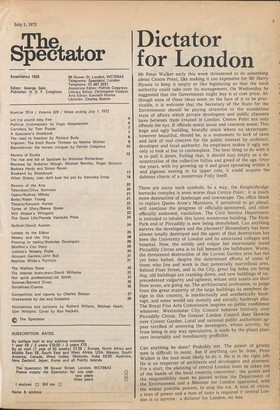Dictator for London
Mr Peter Walker early this week threatened to do something about Centre Point, like making it too expensive for Mr Harry Hyams to keep it empty or like legislating so that the local authority could take over its management. On Wednesday he suggested that the Government might buy it at cost price. Although none of these ideas seem on the face of it to be practicable, it is welcome that the Secretary of the State for the Environment should be paying attention to the scandalous state of affairs which private developers and public planners have between them created in London. Centre Point not only offends the eye. It offends moral sense and common sense. This huge and ugly building, brutally stuck where no skyscraper, however beautiful, should be, is a monument to lack of taste and lack of real concern for the public interest by architect, developer and local authority. Its emptiness makes it ugly not only to look at but to contemplate. The best thing to do with it is to pull it down. Failing that, it should stay empty as a demonstration of the collective follies and greed of the age. Over the years, with ivy growing up it and grass sprouting within it and pigeons nesting in its upper cots, it could acquire the dubious charm of a monstrous Folly itself.
There are many such symbols. In a way, the Knightsbridge barracks complex is even worse than Centre Point : it is much more destructive of landscape and townscape. The office block to replace Queen Anne's Mansions, if permitted to go ahead, will continue the progress of officially-sponsored, and often officially endorsed, vandalism. The Civil Service Department is intended to inhabit this latest monstrous building. The Hyde Park end of Piccadilly is now being demolished. Can anything survive the developers and the planners? Bloomsbury has been almost totally destroyed and the agent of that destruction has been the University of London and its associated colleges and hospital. Now, the untidy and vulgar but enormously loved Piccadilly Circus area is to fall beneath the bulldozers. Worse, the threatened destruction of the Covent Garden area has not yet been halted, despite the determined efforts of some of those who live and work in that potentially marvellous area. Behind Fleet Street, and in the City, great big holes are being dug, old buildings are crashing down, and new buildings of unprecedented vulgarity and ugliness, whose only assets are their floor areas, are going up. The architectural profession, to judge from the great majority of the large buildings its members de sign in this country, is intellectually and aesthetically bank rupt, and some would say morally and socially bankrupt also. The Royal Fine Arts Commission inspires no public confidence whatever. Westminster City Council behaves furtively over Piccadilly Circus. The Greater London Council does likewise over Covent Garden. Local and national public authorities ap pear terrified of annoying the developers, whose activity, far from being in any way speculative, is made by the pliant planners invariably and inordinately profitable.
Can anything be done? Probably not. The power of greedy men is difficult to resist. But if anything can be done, Peter Walker is the man most likely to do it. He is in the right job. He is no respecter of architects and developers and planners. For a start, the planning of central London must be taken out of the hands of the local councils concerned : the power and the responsibility must be placed within the Department of the Environment and a Minister for. London appointed, with the widest pogsible powers, to stop the rot. A man of vision, a man of power and a man of taste is required if central London is to survive : a dictator for London, no less.






















































 Previous page
Previous page